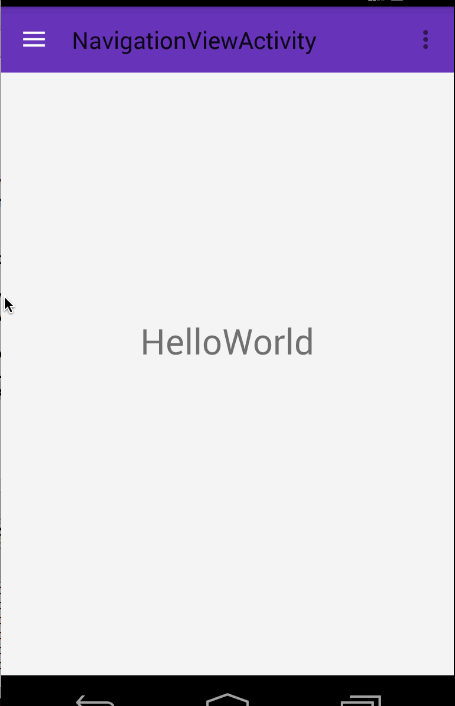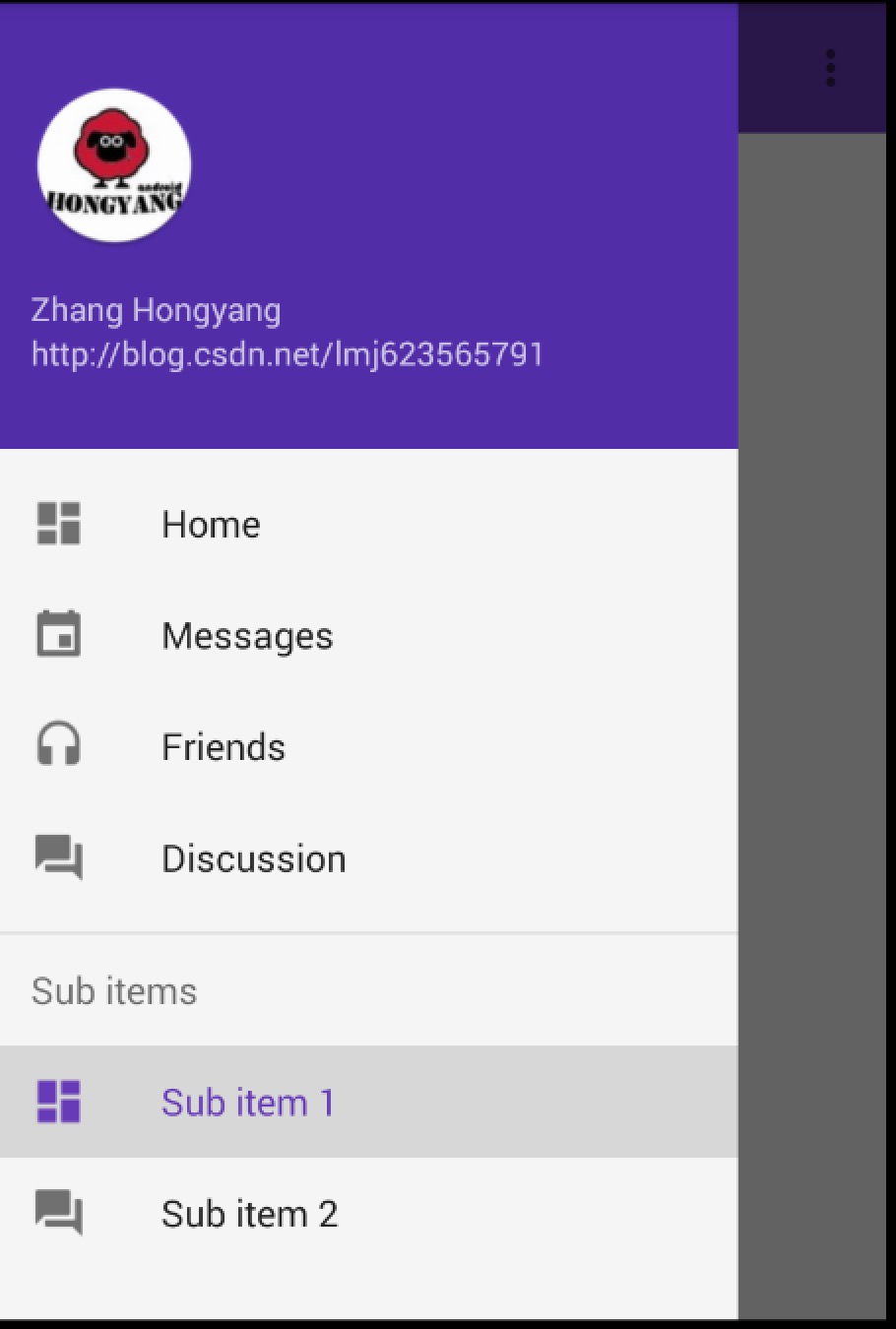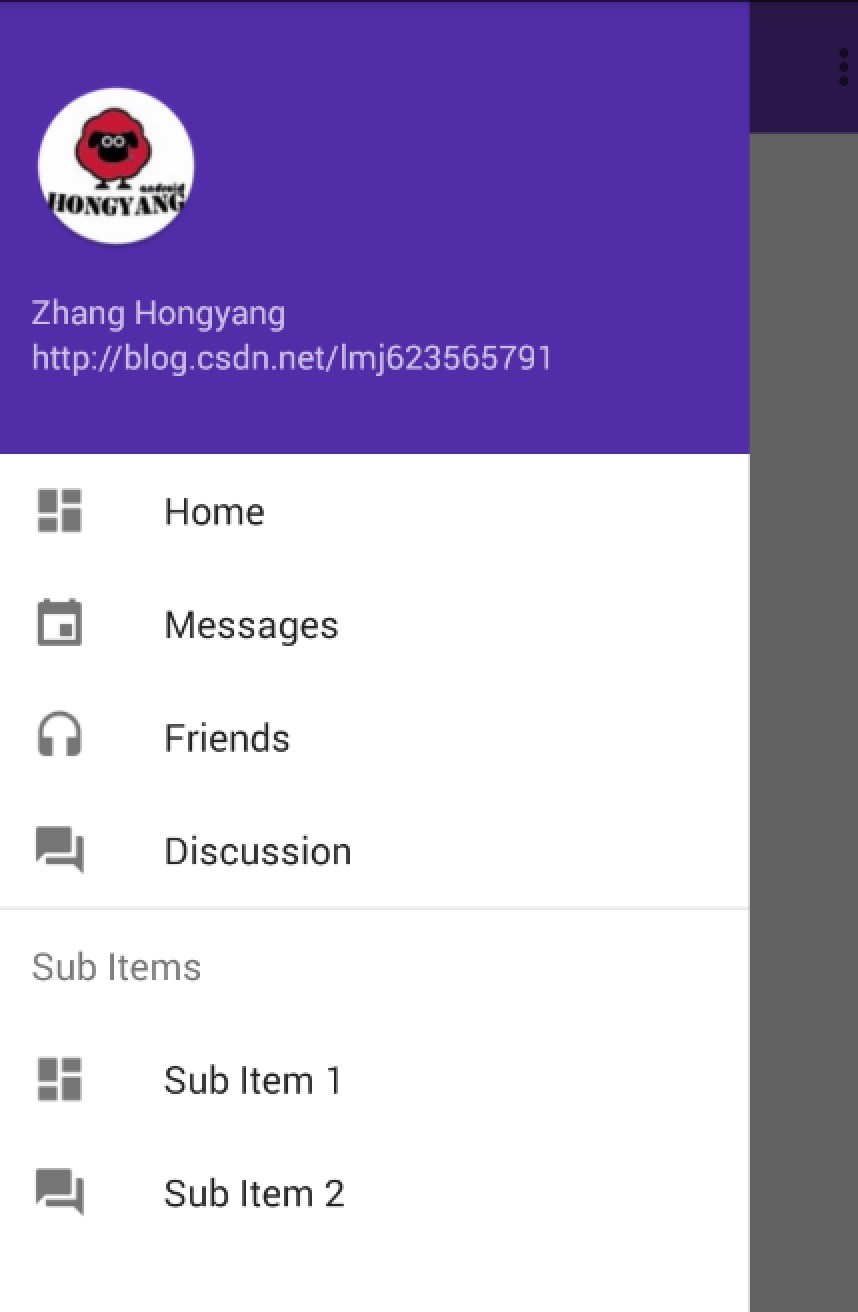Android 自己實現 NavigationView Design Support Library 1
一、概述
Google I/O 2015 給大家帶來了Android Design Support Library,對於希望做md風格的app的來說,簡直是天大的喜訊了~大家可以通過Android Design Support Library該文章對其進行了解,也可以直接在github上下載示例程式碼執行學習。為了表達我心中的喜悅,我決定針對該庫寫一系列的文章來分別介紹新增加的控制元件。
ok,那麼首先介紹的就是NavigationView。
注意下更新下as的SDK,然後在使用的過程中,在build.gradle中新增:
compile 'com.android.support:design:22.2.0'
- 1
在md風格的app中,例如如下風格的側滑選單非常常見:
在之前的設計中,你可能需要考慮如何去佈局實現,例如使用ListView;再者還要去設計Item的選中狀態之類~~
but,現在,google提供了NavigationView,你只需要寫寫佈局檔案,這樣的效果就ok了,並且相容到Android 2.1,非常值得去體驗一下。接下來我們來介紹如何去使用這個NavigationView!
二、使用
使用起來very simple ,主要就是寫寫佈局檔案~
(一)佈局檔案
<?xml version="1.0" encoding="utf-8"?><android.support.v4.widget.DrawerLayout - 1
- 2
- 3
- 4
- 5
- 6
- 7
- 8
- 9
- 10
- 11
- 12
- 13
- 14
- 15
- 16
- 17
- 18
- 19
- 20
- 21
- 22
- 23
- 24
- 25
- 26
- 27
- 28
- 29
- 30
- 31
- 32
- 33
- 34
- 35
- 36
- 37
- 38
- 39
- 40
- 41
- 42
- 43
可以看到我們的最外層是DrawerLayout,裡面一個content,一個作為drawer。我們的drawer為NavigationView。 注意這個view的兩個屬性app:headerLayout="@layout/header_just_username"和app:menu="@menu/menu_drawer",分別代表drawer佈局中的header和menuitem區域,當然你可以根據自己的情況使用。
接下來看看header的佈局檔案和menu配置檔案:
<?xml version="1.0" encoding="utf-8"?><RelativeLayout xmlns:android="http://schemas.android.com/apk/res/android" android:layout_width="match_parent" android:layout_height="192dp" android:background="?attr/colorPrimaryDark" android:orientation="vertical" android:padding="16dp" android:theme="@style/ThemeOverlay.AppCompat.Dark"> <TextView android:id="@+id/id_link" android:layout_width="wrap_content" android:layout_height="wrap_content" android:layout_alignParentBottom="true" android:layout_marginBottom="16dp" android:text="http://blog.csdn.net/lmj623565791"/> <TextView android:id="@+id/id_username" android:layout_width="wrap_content" android:layout_height="wrap_content" android:layout_above="@id/id_link" android:text="Zhang Hongyang"/> <ImageView android:layout_width="72dp" android:layout_height="72dp" android:layout_above="@id/id_username" android:layout_marginBottom="16dp" android:src="@mipmap/icon"/></RelativeLayout>- 1
- 2
- 3
- 4
- 5
- 6
- 7
- 8
- 9
- 10
- 11
- 12
- 13
- 14
- 15
- 16
- 17
- 18
- 19
- 20
- 21
- 22
- 23
- 24
- 25
- 26
- 27
- 28
- 29
- 30
- 31
- 32
- 33
- 34
- 35
- 36
<?xml version="1.0" encoding="utf-8"?><menu xmlns:android="http://schemas.android.com/apk/res/android"> <group android:checkableBehavior="single"> <item android:id="@+id/nav_home" android:icon="@drawable/ic_dashboard" android:title="Home"/> <item android:id="@+id/nav_messages" android:icon="@drawable/ic_event" android:title="Messages"/> <item android:id="@+id/nav_friends" android:icon="@drawable/ic_headset" android:title="Friends"/> <item android:id="@+id/nav_discussion" android:icon="@drawable/ic_forum" android:title="Discussion"/> </group> <item android:title="Sub items"> <menu> <item android:icon="@drawable/ic_dashboard" android:title="Sub item 1"/> <item android:icon="@drawable/ic_forum" android:title="Sub item 2"/> </menu> </item></menu>- 1
- 2
- 3
- 4
- 5
- 6
- 7
- 8
- 9
- 10
- 11
- 12
- 13
- 14
- 15
- 16
- 17
- 18
- 19
- 20
- 21
- 22
- 23
- 24
- 25
- 26
- 27
- 28
- 29
- 30
- 31
- 32
- 33
- 34
別放錯資料夾哈~
佈局檔案寫完了,基本就好了,是不是很爽~看似複雜的效果,寫寫佈局檔案就ok。
ps:預設的顏色很多是從當前的主題中提取的,比如icon的stateColor,當然你也可以通過以下屬性修改部分樣式:
app:itemIconTint=""app:itemBackground=""app:itemTextColor=""- 1
- 2
- 3
(二)Activity
最後是Activity:
package com.imooc.testandroid;import android.os.Bundle;import android.support.design.widget.NavigationView;import android.support.v4.widget.DrawerLayout;import android.support.v7.app.ActionBar;import android.support.v7.app.ActionBarActivity;import android.support.v7.widget.Toolbar;import android.view.MenuItem;public class NavigationViewActivity extends ActionBarActivity{ private DrawerLayout mDrawerLayout; private NavigationView mNavigationView; @Override protected void onCreate(Bundle savedInstanceState) { super.onCreate(savedInstanceState); setContentView(R.layout.activity_navigation_view); mDrawerLayout = (DrawerLayout) findViewById(R.id.id_drawer_layout); mNavigationView = (NavigationView) findViewById(R.id.id_nv_menu); Toolbar toolbar = (Toolbar) findViewById(R.id.id_toolbar); setSupportActionBar(toolbar); final ActionBar ab = getSupportActionBar(); ab.setHomeAsUpIndicator(R.drawable.ic_menu); ab.setDisplayHomeAsUpEnabled(true); setupDrawerContent(mNavigationView); } private void setupDrawerContent(NavigationView navigationView) { navigationView.setNavigationItemSelectedListener( new NavigationView.OnNavigationItemSelectedListener() { @Override public boolean onNavigationItemSelected(MenuItem menuItem) { menuItem.setChecked(true); mDrawerLayout.closeDrawers(); return true; } }); } @Override public boolean onCreateOptionsMenu(Menu menu) { // Inflate the menu; this adds items to the action bar if it is present. getMenuInflater().inflate(R.menu.menu_navigation_view, menu); return true; } @Override public boolean onOptionsItemSelected(MenuItem item) { if(item.getItemId() == android.R.id.home) { mDrawerLayout.openDrawer(GravityCompat.START); return true ; } return super.onOptionsItemSelected(item); }}- 1
- 2
- 3
- 4
- 5
- 6
- 7
- 8
- 9
- 10
- 11
- 12
- 13
- 14
- 15
- 16
- 17
- 18
- 19
- 20
- 21
- 22
- 23
- 24
- 25
- 26
- 27
- 28
- 29
- 30
- 31
- 32
- 33
- 34
- 35
- 36
- 37
- 38
- 39
- 40
- 41
- 42
- 43
- 44
- 45
- 46
- 47
- 48
- 49
- 50
- 51
- 52
- 53
- 54
- 55
- 56
- 57
- 58
- 59
- 60
- 61
- 62
- 63
- 64
- 65
- 66
- 67
- 68
- 69
- 70
- 71
- 72
- 73
- 74
- 75
- 76
- 77
我們在Activity裡面可以通過navigationView去navigationView.setNavigationItemSelectedListener,當selected的時候,menuItem去setChecked(true)。
別忘了設定theme~
<resources> <!-- Base application theme. --> <style name="AppTheme" parent="Theme.AppCompat.Light.DarkActionBar"> <!-- Customize your theme here. --> </style> <style name="Theme.DesignDemo" parent="Base.Theme.DesignDemo"></style> <style name="Base.Theme.DesignDemo" parent="Theme.AppCompat.Light.NoActionBar"> <item name="colorPrimary">#673AB7</item> <item name="colorPrimaryDark">#512DA8</item> <item name="colorAccent">#FF4081</item> <item name="android:windowBackground">@color/window_background</item> </style></resources><color name="window_background">#FFF5F5F5</color> <activity android:name=".NavigationViewActivity" android:label="@string/title_activity_navigation_view" android:theme="@style/Theme.DesignDemo"></activity>- 1
- 2
- 3
- 4
- 5
- 6
- 7
- 8
- 9
- 10
- 11
- 12
- 13
- 14
- 15
- 16
- 17
- 18
- 19
- 20
- 21
- 22
- 23
- 24
- 25
- 26
- 27
- 28
ok,到此就搞定了~~
不過存在一個問題,此時你如果點選Sub items裡面的Sub item,如果你期望當前選中應該是Sub item,你會發現不起作用。那怎麼辦呢?
(三)Sub Item支援Cheable
這裡可以修改menu的配置檔案:
<?xml version="1.0" encoding="utf-8"?><menu xmlns:android="http://schemas.android.com/apk/res/android"> <group> <item android:id="@+id/nav_home" android:checkable="true" android:icon="@drawable/ic_dashboard" android:title="Home"/> <item android:id="@+id/nav_messages" android:checkable="true" android:icon="@drawable/ic_event" android:title="Messages"/> <item android:id="@+id/nav_friends" android:checkable="true" android:icon="@drawable/ic_headset" android:title="Friends"/> <item android:id="@+id/nav_discussion" android:checkable="true" android:icon="@drawable/ic_forum" android:title="Discussion"/> </group> <item android:title="Sub items"> <menu> <item android:checkable="true" android:icon="@drawable/ic_dashboard" android:title="Sub item 1"/> <item android:checkable="true" android:icon="@drawable/ic_forum" android:title="Sub item 2"/> </menu> </item></menu>- 1
- 2
- 3
- 4
- 5
- 6
- 7
- 8
- 9
- 10
- 11
- 12
- 13
- 14
- 15
- 16
- 17
- 18
- 19
- 20
- 21
- 22
- 23
- 24
- 25
- 26
- 27
- 28
- 29
- 30
- 31
- 32
- 33
- 34
- 35
- 36
- 37
- 38
- 39
- 40
將android:checkableBehavior="single"去掉,然後給每個item項新增android:checkable="true"。
然後在程式碼中:
navigationView.setNavigationItemSelectedListener( new NavigationView.OnNavigationItemSelectedListener() { private MenuItem mPreMenuItem; @Override public boolean onNavigationItemSelected(MenuItem menuItem) { if (mPreMenuItem != null) mPreMenuItem.setChecked(false); menuItem.setChecked(true); mDrawerLayout.closeDrawers(); mPreMenuItem = menuItem; return true; } });- 1
- 2
- 3
- 4
- 5
- 6
- 7
- 8
- 9
- 10
- 11
- 12
- 13
- 14
- 15
- 16
- 17
存一下preMenuItem,手動切換。
效果:
ok,哈~其實這個還是參考連結2裡面的一個評論說的~~
到此用法就介紹完了有木有一點小激動~ 但是還有個問題,對於app,就像ActionBar最初的出現,一開始大家都歡欣鼓舞,後來發現app中多數情況下需要去定製,尼瑪,是不是忽然覺得ActionBar太死板了,噁心死了(當然了現在有了ToolBar靈活度上好多了)對於上述NavigationView可能也會存在定製上的問題,比如我希望選中的Item左邊有個高亮的豎線之類的效果。那麼,針對於各種需求,想要能解決各種問題,最好的方式就是說對於NavigationView的效果自己可以實現。最好,我們就來看看NavigationView自己實現有多難?
三、自己實現NavigationView效果
其實NavigationView的實現非常簡單,一個ListView就可以了,甚至都不需要去自定義,簡單寫一個Adapter就行了~~
首先觀察該圖,有沒有發現神奇之處,恩,你肯定發現不了,因為我們做的太像了。
其實這個圖就是我通過ListView寫的一個~是不是和原版很像(~哈~參考了原始碼的實現,當然像。)
接下來分析,如果說是ListView,那麼Item的type肯定不止一種,那我們數一數種類:
- 帶圖示和文字的
- 僅僅是文字的 Sub Items
- 分割線
你會說還有頂部那個,頂部是headview呀~~
這麼分析完成,是不是瞬間覺得沒有難度了~
(一)首先佈局檔案
<?xml version="1.0" encoding="utf-8"?><android.support.v4.widget.DrawerLayout android:id="@+id/id_drawer_layout" xmlns:android="http://schemas.android.com/apk/res/android" xmlns:app="http://schemas.android.com/apk/res-auto" android:layout_width="match_parent" android:layout_height="match_parent" android:fitsSystemWindows="true" > <RelativeLayout android:layout_width="match_parent" android:layout_height="match_parent"> <android.support.v7.widget.Toolbar android:id="@+id/id_toolbar" android:layout_width="match_parent" android:layout_height="?attr/actionBarSize" android:background="?attr/colorPrimary" app:layout_scrollFlags="scroll|enterAlways" app:popupTheme="@style/ThemeOverlay.AppCompat.Light"/> <TextView android:id="@+id/id_tv_content" android:layout_width="wrap_content" android:layout_height="wrap_content" android:layout_centerInParent="true" android:text="HelloWorld" android:textSize="30sp"/> </RelativeLayout> <ListView android:id="@+id/id_lv_left_menu" android:layout_width="match_parent" android:layout_height="match_parent" android:layout_gravity="start" android:paddingTop="0dp" android:background="#ffffffff" android:clipToPadding="false" android:divider="@null" android:listSelector="?attr/selectableItemBackground" /></android.support.v4.widget.DrawerLayout>- 1
- 2
- 3
- 4
- 5
- 6
- 7
- 8
- 9
- 10
- 11
- 12
- 13
- 14
- 15
- 16
- 17
- 18
- 19
- 20
- 21
- 22
- 23
- 24
- 25
- 26
- 27
- 28
- 29
- 30
- 31
- 32
- 33
- 34
- 35
- 36
- 37
- 38
- 39
- 40
- 41
- 42
- 43
- 44
- 45
佈局檔案上:和上文對比,我們僅僅把NavigationView換成了ListView.
下面注意了,一大波程式碼來襲.
(二) Activity
package com.imooc.testandroid;public class NavListViewActivity extends ActionBarActivity{ private ListView mLvLeftMenu; private DrawerLayout mDrawerLayout; @Override protected void onCreate(Bundle savedInstanceState) { super.onCreate(savedInstanceState); setContentView(R.layout.activity_nav_list_view); mDrawerLayout = (DrawerLayout) findViewById(R.id.id_drawer_layout); mLvLeftMenu = (ListView) findViewById(R.id.id_lv_left_menu); Toolbar toolbar = (Toolbar) findViewById(R.id.id_toolbar); setSupportActionBar(toolbar); final ActionBar ab = getSupportActionBar(); ab.setHomeAsUpIndicator(R.drawable.ic_menu); ab.setDisplayHomeAsUpEnabled(true); setUpDrawer(); } private void setUpDrawer() { LayoutInflater inflater = LayoutInflater.from(this); mLvLeftMenu.addHeaderView(inflater.inflate(R.layout.header_just_username, mLvLeftMenu, false)); mLvLeftMenu.setAdapter(new MenuItemAdapter(this)); } @Override public boolean onCreateOptionsMenu(Menu menu) { // Inflate the menu; this adds items to the action bar if it is present. getMenuInflater().inflate(R.menu.menu_nav_list_view, menu); return true; } @Override public boolean onOptionsItemSelected(MenuItem item) { // Handle action bar item clicks here. The action bar will // automatically handle clicks on the Home/Up button, so long // as you specify a parent activity in AndroidManifest.xml. int id = item.getItemId(); //noinspection SimplifiableIfStatement if (id == android.R.id.home) { mDrawerLayout.openDrawer(GravityCompat.START); return true; } return super.onOptionsItemSelected(item); }}- 1
- 2
- 3
- 4
- 5
- 6
- 7
- 8
- 9
- 10
- 11
- 12
- 13
- 14
- 15
- 16
- 17
- 18
- 19
- 20
- 21
- 22
- 23
- 24
- 25
- 26
- 27
- 28
- 29
- 30
- 31
- 32
- 33
- 34
- 35
- 36
- 37
- 38
- 39
- 40
- 41
- 42
- 43
- 44
- 45
- 46
- 47
- 48
- 49
- 50
- 51
- 52
- 53
- 54
- 55
- 56
- 57
- 58
- 59
- 60
- 61
- 62
- 63
- 64
直接看onCreate中的setUpDrawer(),可以看到我們首先去addHeadView,然後去setAdapter。
那麼核心程式碼就是我們的Adapter了~~
(三)MenuItemAdapter
public class LvMenuItem { public LvMenuItem(int icon, String name) { this.icon = icon; this.name = name; if (icon == NO_ICON && TextUtils.isEmpty(name)) { type = TYPE_SEPARATOR; } else if (icon == NO_ICON) { type = TYPE_NO_ICON; } else { type = TYPE_NORMAL; } if (type != TYPE_SEPARATOR && TextUtils.isEmpty(name)) { throw new IllegalArgumentException("you need set a name for a non-SEPARATOR item"); } L.e(type + ""); } public LvMenuItem(String name) { this(NO_ICON, name); } public LvMenuItem() { this(null); } private static final int NO_ICON = 0; public static final int TYPE_NORMAL = 0; public static final int TYPE_NO_ICON = 1; public static final int TYPE_SEPARATOR = 2; int type; String name; int icon; } public class MenuItemAdapter extends BaseAdapter { private final int mIconSize; private LayoutInflater mInflater; private Context mContext; public MenuItemAdapter(Context context) { mInflater = LayoutInflater.from(context); mContext = context; mIconSize = context.getResources().getDimensionPixelSize(R.dimen.drawer_icon_size);//24dp } private List<LvMenuItem> mItems = new ArrayList<LvMenuItem>( Arrays.asList( new LvMenuItem(R.drawable.ic_dashboard, "Home"), new LvMenuItem(R.drawable.ic_event, "Messages"), new LvMenuItem(R.drawable.ic_headset, "Friends"), new LvMenuItem(R.drawable.ic_forum, "Discussion"), new LvMenuItem(), new LvMenuItem("Sub Items"), new LvMenuItem(R.drawable.ic_dashboard, "Sub Item 1"), new LvMenuItem(R.drawable.ic_forum, "Sub Item 2") )); @Override public int getCount() { return mItems.size(); } @Override public Object getItem(int position) { return mItems.get(position); } @Override public long getItemId(int position) { return position; } @Override public int getViewTypeCount() { return 3; } @Override public int getItemViewType(int position) { return mItems.get(position).type; } @Override public View getView(int position, View convertView, ViewGroup parent) { LvMenuItem item = mItems.get(position); switch (item.type) { case LvMenuItem.TYPE_NORMAL: if (convertView == null) { convertView = mInflater.inflate(R.layout.design_drawer_item, parent, false); } TextView itemView = (TextView) convertView; itemView.setText(item.name); Drawable icon = mContext.getResources().getDrawable(item.icon); setIconColor(icon); if (icon != null) { icon.setBounds(0, 0, mIconSize, mIconSize); TextViewCompat.setCompoundDrawablesRelative(itemView, icon, null, null, null); } break; case LvMenuItem.TYPE_NO_ICON: if (convertView == null) { convertView = mInflater.inflate(R.layout.design_drawer_item_subheader, parent, false); } TextView subHeader = (TextView) convertView; subHeader.setText(item.name); break; case LvMenuItem.TYPE_SEPARATOR: if (convertView == null) { convertView = mInflater.inflate(R.layout.design_drawer_item_separator, parent, false); } break; } return convertView; } public void setIconColor(Drawable icon) { int textColorSecondary = android.R.attr.textColorSecondary; TypedValue value = new TypedValue(); if (!mContext.getTheme().resolveAttribute(textColorSecondary, value, true)) { return; } int baseColor = mContext.getResources().getColor(value.resourceId); icon.setColorFilter(baseColor, PorterDuff.Mode.MULTIPLY); } }- 1
- 2
- 3
- 4
- 5
- 6
- 7
- 8
- 9
- 10
- 11
- 12
- 13
- 14
- 15
- 16
- 17
- 18
- 19
- 20
- 21
- 22
- 23
- 24
- 25
- 26
- 27
- 28
- 29
- 30
- 31
- 32
- 33
- 34
- 35
- 36
- 37
- 38
- 39
- 40
- 41
- 42
- 43
- 44
- 45
- 46
- 47
- 48
- 49
- 50
- 51
- 52
- 53
- 54
- 55
- 56
- 57
- 58
- 59
- 60
- 61
- 62
- 63
- 64
- 65
- 66
- 67
- 68
- 69
- 70
- 71
- 72
- 73
- 74
- 75
- 76
- 77
- 78
- 79
- 80
- 81
- 82
- 83
- 84
- 85
- 86
- 87
- 88
- 89
- 90
- 91
- 92
- 93
- 94
- 95
- 96
- 97
- 98
- 99
- 100
- 101
- 102
- 103
- 104
- 105
- 106
- 107
- 108
- 109
- 110
- 111
- 112
- 113
- 114
- 115
- 116
- 117
- 118
- 119
- 120
- 121
- 122
- 123
- 124
- 125
- 126
- 127
- 128
- 129
- 130
- 131
- 132
- 133
- 134
- 135
- 136
- 137
- 138
- 139
- 140
- 141
- 142
- 143
- 144
- 145
- 146
- 147
- 148
- 149
- 150
- 151
- 152
- 153
- 154
- 155
- 156
- 157
- 158
- 159
- 160
- 161
- 162
- 163
- 164
- 165
- 166
首先我們的每個Item對應於一個LvMenuItem,包含icon、name、type,可以看到我們的type分為3類。
那麼adapter中程式碼就很簡單了,多Item佈局的寫法。
這樣就完成了,我們自己去書寫NavigationView,是不是很簡單~~如果你的app需要類似效果,但是又與NavigationView的效果並非一模一樣,可以考慮按照上面的思路自己寫一個。
最後貼一下用到的Item的佈局檔案:
- design_drawer_item_subheader.xml
<?xml version="1.0" encoding="utf-8"?><TextView xmlns:android="http://schemas.android.com/apk/res/android" android:layout_width="match_parent" android:layout_height="?attr/listPreferredItemHeightSmall" android:gravity="center_vertical|start" android:maxLines="1" android:paddingLeft="?attr/listPreferredItemPaddingLeft" android:paddingRight="?attr/listPreferredItemPaddingRight" android:textAppearance="?attr/textAppearanceListItem" android:textColor="?android:textColorSecondary"/>- 1
- 2
- 3
- 4
- 5
- 6
- 7
- 8
- 9
- 10
- 11
- design_drawer_item_separator.xml
<?xml version="1.0" encoding="utf-8"?><FrameLayout xmlns:android="http://schemas.android.com/apk/res/android" android:layout_width="match_parent" android:layout_height="wrap_content"> <View android:layout_width="match_parent" android:layout_height="1dp" android:background="?android:attr/listDivider"/></FrameLayout>- 1
- 2
- 3
- 4
- 5
- 6
- 7
- 8
- 9
- 10
- 11
- 12
- design_drawer_item,xml:
<?xml version="1.0" encoding="utf-8"?><TextView xmlns:android="http://schemas.android.com/apk/res/android" android:layout_width="match_parent" android:layout_height="?attr/listPreferredItemHeightSmall" android:paddingLeft="?attr/listPreferredItemPaddingLeft" android:paddingRight="?attr/listPreferredItemPaddingRight" android:drawablePadding="32dp" android:gravity="center_vertical|start" android:maxLines="1" android:textAppearance="?attr/textAppearanceListItem" android:textColor="?android:attr/textColorPrimary"/>- 1
- 2
- 3
- 4
- 5
- 6
- 7
- 8
- 9
- 10
- 11
- 12
ok,其實上述ListView的寫法也正是NavigationView的原始碼實現~~item的佈局檔案直接從原始碼中拖出來的,還是爽爽噠~
原始碼點選下載 ~~hava a nice day ~~
微信公眾號:hongyangAndroid (歡迎關注,第一時間推送博文資訊)




